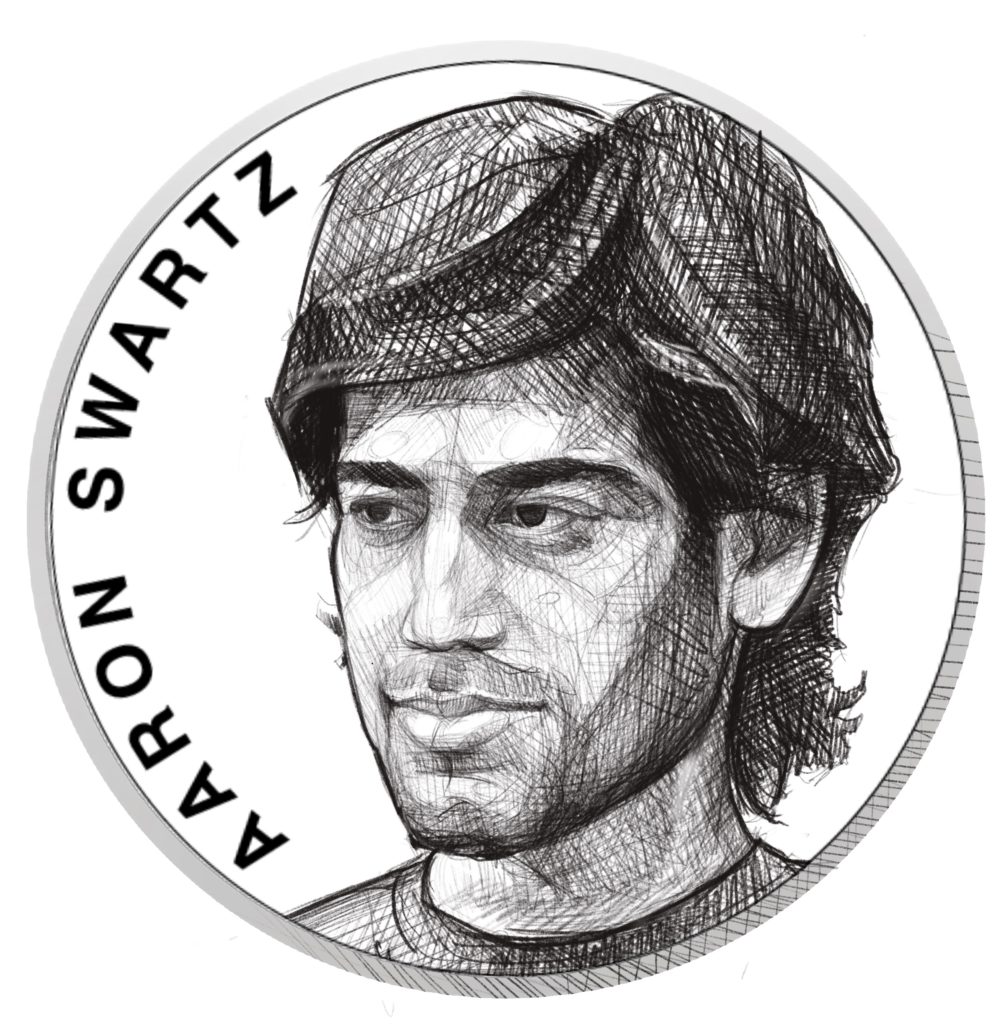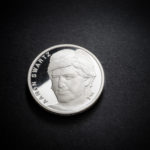The 2019 Coin Commemorates the Struggle of Aaron Swartz
Aaron Swartz (1986-2011) was an American visionary, hacker, political and internet activist and one of the most talented IT experts of his generation. Beginning as an ordinary user of freeware programs, through open-source development, Aaron became involved in the activities of a movement supporting free data sharing and access to scholarly texts and information. His young life dedicated to fight for digital freedom came to an untimely end when the state deemed him guilty for his desire to allow access to education for everybody. Timothy B. Lee, the creator of World Wide Web and director of the W3 Consortium as well as Aaron’s major influence, spoke of him as of one of the greatest IT geniuses of his generation.
Aaron Swartz 2019 Edition:
| Total Issue: | 100 pcs |
| Year od Emission: | 2019 |
| Diameter: | 37 mm |
| Width: | 3 mm |
| Material: | silver |
| Fineness: | 999/1000 |
| Version: | 50 pcs proof 50 pcs mat |
The Work of a 12-Year-Old That Still Inspires Us Today
During his life, Aaron Swartz cooperated on many software development projects including RSS, Markdown, Jottit, Infogami or Reddit. The last mentioned is an open social network with a worldwide user base of approximately 540 million unique users from more than 200 countries. His school-project foreshadowed Wikipedia and he is also one of the authors behind Creative Commons.
When he was twelve, Aaron programmed The Info Network at home – an internet encyclopaedia operating on the basis of user-generated content. Five years later (in 2001), Wikipedia was founded. For his home project, Aaron was awarded first place in the ArsDigita Prize contest and was afterwards invited to RDF Core Working Group – a top international organization developing web standards.
A year later, he contributed to the creation of the RSS format which is today a fixed and standardized part of the web. Thanks to RSS, internet users can set up a subscription to various pages with fast changing content such as social networks or news sites. The thirteen-year-old Aaron brought a revolutionary technical solution and laid base for the modern version of hypertext.
In 2004 at Stanford, he met Larry Lessig, professor of Law and Ethics and an active member of the Free Culture Movement, who is the father of the Creative Commons Licence – a legal norm legalising the sharing and modification of certain digital creative works.
When Aaron Displeased the State
Later Aaron became vocal in defence of human rights and freedom of speech, thus shifting from the online environment towards the waters of political activism. He founded Demand Progress, a group often criticizing the actions of major US political structures including the Congress and the President. The main activities of the group lead towards the elimination of those internet services which prevented free access to materials which should be publicly accessible for free. One such service was the court records database Pacer which although it had public domain licence, required payment for access. They also protested against the Child Online Protection Act which was based on a highly vague and easily manipulated definition of what exactly is an “unsuitable document” (Brdička, 2013).
One of Aaron’s last projects before he died was the open-source software platform SecureDrop aiming to support and protect whistle-blowers. This technology, which is today heavily used by world media for secure procurement of information from the source, alerts journalists of dishonest practice.
United States of America v. Aaron Swartz
Swartz never attacked the US government. His activities aimed at entities which tried to monetize access to not only scholarly texts, but also to information that should be freely accessible to all. One such was the database of scholarly articles JSTOR which charges dozens of dollars even for historical articles without copyright protection – allegedly due to the expenses required for their digitalization. JSTOR and similar services offer multi licences to universities allowing their students and academic workers access to content. One of the universities is The Massachusetts Institute of Technology (MIT) to whose network Aaron gained access when he studied at neighbouring Harvard. Repeatedly he downloaded and, on his laptop, carried out of the university over 4 million academic articles with the intention of publishing them. Last time he did so was on 6th January 2011, when he was apprehended while trying to access an unlocked server-room.
At least since 2008, however, Aaron was known to the FBI. At that time, he contributed to the downloading and illegal publicizing of more than 20 million pages of court records from PACER. Not only was this project greatly successful, it also revealed substantial breach of privacy in the documents. FBI did not press any charges (echo24.cz, 2015).
Swartz was prosecuted for violating the Computer Fraud and Abuse Act of 1986. He was indicted with 13 charges including breaking and entering, computer fraud and unlawfully obtaining information from a protected computer together with larceny. JSTOR ultimately dropped charges while MIT did not press any. Federal prosecutors aimed for the highest possible penalty which in Swartz’s case could have been up to 35 years in prison (Brdička, 2013). Aaron Swartz hanged himself in his Brooklyn apartment a few days before the commencement of the final phase of the trial.
Swartz did not commit his offences for a financial or other personal profit and there was no need for such high cumulative penalty in his case. We can talk of an extreme failure of the American justice system as well as a case when an individual was to become an exemplary case with no regard to the actual severity of his offense. After his death, it became clear that the FBI were collecting evidence against him even before 2008 and the whole process was prepared years before his arrest.
Author of the Design
The author of the coin’s design is Roman Shamilyan, twenty-six-year old creator, engraver and tattoo artist. At the beginning of the process of creation of each coin is the making of the basic layout, drawing and a clay model. Professional detailed craftwork ultimately makes more than half of the success. A lot of rules must be followed which makes this process different from traditional sculpture. Otherwise, the final plaster case would be unusable and the coin process could not proceed into its next phase.
In 2013, Roman successfully completed his studies in Luxury Goods and Jewellery at SUPŠ in Jablonec nad Nisou. As a medal artist, he already had twelve commissions from the Czech Mint. You can see his work also on the bodies of hundreds of clients of Show me! Tattoo studio, for he applies his skill also in this craft.

3D Cases by Prototypum for the 2019 Edition
In 2019, we have started collaboration with industrial designers and innovators from the Prototypum company who created unique collection of cases for the coins, from design to 3D print: “The idea for the design of cases for this unique coin collection came from the very concept of the project, that is from the symbolism of the coins which pay respect to individuals who with their work and deeds fought against the cleaving of liberty by the state and who were charged, judged and imprisoned for it by the system. The design of the case vaguely represents prison bars and at the same plays an interesting optical trick where, from a certain angle, the coin is visible in the case. Given that Paralelní polis aims to connect art with science and technology, 3D print as the creative technology was always a clear choice for us.
– More about Prototypum’s work and products
How Do I Check My Coin’s Balance?
- To check the balance on your coin, go to https://coinb.in/#verify. The code on the edge of your coin is the private key in WIF format (Priv1). Type it in to the box and hit submit.
- Write down the generated public key (Pub1).
- With a QR reader, scan your BitNote QR code. This code is the second half of the key (Pub2). Copy it.
- Check the validity of your Pub2: Paste the Pub2 into the box (again at https://coinb.in/#verify) and submit.
- Your public key has been changed to a bitcoin address (Legacy Address column). This address should be the same as the one in your BitNote scratch-off field.
- To obtain Multisig address, go to https://coinb.in/#newMultiSig and insert you Pub1 and Pub2 codes. In this order!
- The address which will be assigned to you should start with 3 and the transaction of 0.01 BTC should be there. You can check the registration of this transaction on Blockchain at https://www.blockchain.com/explorer
How Do I Get My 0.01 BTC from the Coin?
- To obtain the bitcoin value of your coin, go to https://coinb.in/#verify. The code on the edge of your coin is the private key in WIF format (Priv1). Type it in to the box and hit submit.
- Write down the generated public key (Pub1).
- With a QR reader, scan your BitNote QR code. This code is the second half of the key (Pub2). Copy it.
- To obtain a “Redeem Script,” go to https://coinb.in/#newMultiSig and enter your Pub1 and Pub2 into the fields in this order.
- With the Redeem Script, you can now create a new transaction. The value should be 0.01 minus the recommended fee. You can estimate the fee at bitcoinfees.earn.com.
- Sign the transaction with your key from under the scratch-off holographic foil.
I Am Interested in Purchasing the Coin
If you wish to purchase the Aaron Swartz 2019 coin, please contact us at minceparalelnipolis@gmail.com. There are also 10 pieces from the Julian Assange 2018 edition still available. We will be happy to present you with the coin in person at Paralelní Polis or send it to your address.




